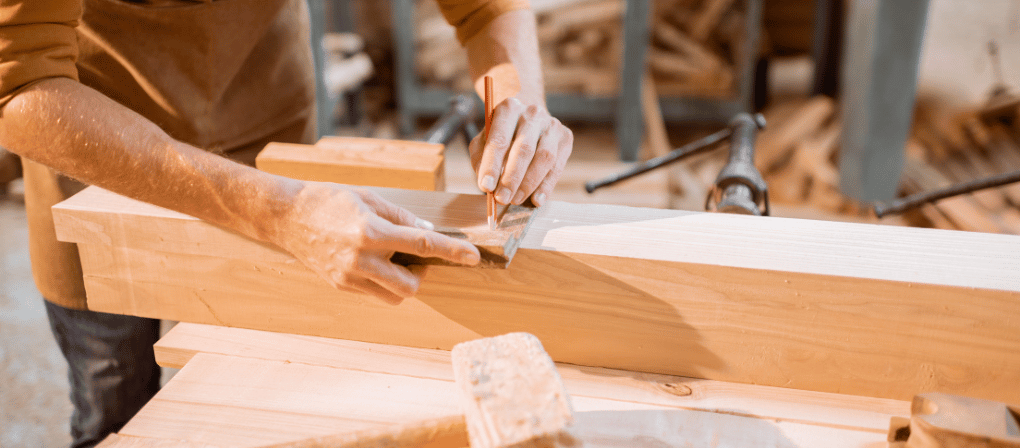Adding texture to woodwork can significantly enhance its visual appeal and add character to your projects, transforming ordinary surfaces into captivating works of art. Often, achieving texture involves thinking creatively about the tools you already have at your disposal.
While some tools are designed for specific tasks, they can be repurposed to create unique textures and finishes on wood surfaces. Here, we’ll delve deeper into twelve ways to add texture using tools you likely already have in your workshop:
Nail Set:
- Best Use: Suitable for most woods, ideal for small to medium-sized areas.
- What to do: Use a mallet or hammer to create shallow or deep dimples in the wood.
- Effect: Creates an even, light texture, great for filling in smaller areas.
Carving Gouge:
- Best Use: Works well in most woods, suitable for covering large surfaces.
- What to do: Use both hands to control the gouge, creating shallow or deep grooves.
- Effect: Shallow grooves feel delicate, while deeper grooves add dramatic texture.
Awl:
- Best Use: Effective in most woods, ideal for small areas requiring light texture.
- What to do: Slowly add tiny dimples to the wood using a mallet or hammer.
- Effect: Creates a very light, even texture in smaller areas.
Cold Chisel:
- Best Use: Great for creating textured borders or larger surfaces.
- What to do: Similar to using an awl or nail set, strike lightly for subtle results or heavily for deeper grooves.
- Effect: Leaves narrow, long triangular grooves on the wood surface.
Screw or Lag Bolt:
- Best Use: Works best on softer woods, suitable for creating borders near the edge of a workpiece.
- What to do: Use a hammer to press the threads of the screw or bolt into the wood surface.
- Effect: Creates small marks adding slight texture, with variations possible by changing angles and striking points.
Router:
- Best Use: Versatile tool suitable for all woods and various situations, can create dramatic texture over small or large surfaces.
- What to do: Use a router with different bits and passes to control the texture.
- Effect: Offers numerous texturing possibilities, including circular grooves or custom patterns.
Chisel:
- Best Use: Ideal for adding texture to outside surfaces, suitable for any wood density.
- What to do: Use a sharp chisel to create faceted surfaces, working downhill to reduce tear-out.
- Effect: Adds subtle texture, playing a more understated role in woodworking projects.
Rotary Tool:
- Best Use: Effective for creating subtle, even texture on flat or round surfaces.
- What to do: Systematically move the tool over the workpiece to create small cuts.
- Effect: Offers a tight, simple texture, with results depending on bit selection.
Round Nail Head:
- Best Use: Suitable for small areas of light texture on softer woods.
- What to do: Smooth the nail head and use a hammer to create concave dimples in the wood.
- Effect: Creates smooth, concave dimples that can be spaced evenly or randomly.
Wood-Burning Pen:
- Best Use: Effective for adding deeper texture on softer woods, great for smaller areas.
- What to do: Adjust the temperature and use the pen tip to burn marks into the wood surface.
- Effect: Leaves small recesses in the wood with a visually appealing burnt effect.
Round File:
- Best Use: Ideal for working on corners of most woods, suitable for creating notches.
- What to do: Guide the file into the wood at a 45º angle to create a row of notches.
- Effect: Creates a row of notches along the edge of a workpiece.
Angle Grinder:
- Best Use: Works well in most woods for creating heavily textured surfaces.
- What to do: Move the grinder across the workpiece in a sweeping motion, experimenting with different speeds and angles.
- Effect: Produces a heavily textured, wavy surface with variations possible using different cutting attachments.
By utilizing these techniques with the tools, you already have, you can add unique textures and finishes to your woodworking projects, enhancing their visual appeal and making them truly stand out.
Experiment with different tools and methods to discover the textures that best complement your designs and style preferences. Remember, woodworking is as much about creativity and exploration as it is about precision and technique.
With these methods, you have a wealth of options to add texture and depth to your next woodworking masterpiece.
Visit you local Build it Hermanus instore for all your tools and building supplies today! Follow us on social media to stay updated on our latest specials and promotions. Build it Hermanus – where your dreams take shape.
Build it Hermanus offers added value services in respect of hardware retailing; embracing all activity within the building materials industry, focusing specifically on the building of; urban, township, rural housing as well as all home improvements and do it yourself.
